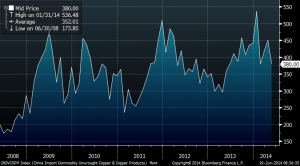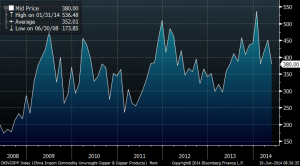The geopolitical landscape created by the Ukraine crisis and the ongoing sanctions against Russian interests from both the EU and US have made the MICEX Index fall 4% YTD.
For investors, the main things to consider:
– Russian stocks are cheap and they have always been. Headline multiples disguise a market where the semi-state owned companies tend to pursue a strategy that is less focused on total-shareholder-return than on maximizing capex. State intervention and value destructing investments have been some of the factors behind the de-rating of Russian stocks.
On the flipside, Russian independent companies have been following a very shareholder oriented policy (think Novatek, for example), reacting inmediately to rumours and creating value by being focused. So the index large weights cloud a market where some companies do shine and develop solid strategies.
Therefore, for investors, the key is stock picking, not index buying… and focusing on clear strategy independent companies, not necessarily on the “headline cheap” multi-megacap conglomerates. These are OK for a short term technical trade driven more by oil price momentum and geopolitical risks easing.
– Ruble strength is likely as oil prices remain high, and with low debt and little financial dependence on foreign entities, Russia can sustain the economic slowdown created by sanctions better than the EU debt-ridden countries with strong commercial ties with Russia. The current oil price-ruble combination prevents any risk of economic collapse in Russia and, to a limited extent, the state can substitute for foreign lenders in strategic sectors. However, without a big pick-up in inward investment and domestic confidence, the economy will not be able to move from near stagnation to the sustainable 3-4% annualized growth it needs, according to Chris Weafer. Russia’s balance sheet and budget are solid and the government can afford to provide domestic funding to banks or to raise public investments.
– Besides the human tragedy, the consequences of the MH17 crash may also be less lending from European banks to Russian companies, which could make the Russian economy even more isolated on markets. The direct impact on European credit is likely to be contained however, as exposure to Russia is already limited (with the exception of Austrian banks), according to RBS. But in a worst-case scenario, Europe remains dependent on Russian gas. Today there is no risk as gas inventories are at five year highs (83%) but any cuts to supply could make several countries vulnerable during the winter.
– The US is imposing sanctions with the EU’s pocket. The US has very limited exposure to Russia, while the EU -and countries such as Italy or France in particular- are heavily exposed.
Additional read: Check Chris Weafer, one of the top experts on Russia, from Macro Advisory.
Important Disclaimer: All of Daniel Lacalle’s views expressed in this blog are strictly personal and should not be taken as buy or sell recommendations.





